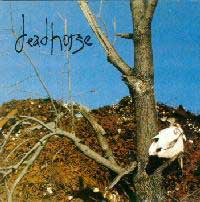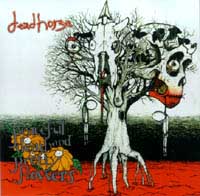dead horse
The founding member of Houston's underground scene during the late 1980s dead horse mixed thrash with local forms of music to produce aggravated, interesting and increasingly musically literate metal crossover material. The musicians have now moved on to alternative rock but for an era they were underground legends.
HORSECORE: AN UNRELATED STORY THAT'S TIME CONSUMING
Relapse
|
1988/1999
|
|
|
Production: Decent, clear and more rich in tone than most of this era.
Review: It seems paradoxical that dead horse unified multiple threads of the tradition that would become underground metal: the traversal of rock n roll to form a new style of music with a signature nihilism and esotericism. In the death-tinged thrash that is dead horse, elements of rock, country, jazz and blues coexist with blasting shreds of structure in fragmentary, chromatic and tonally anarchistic heaviness.
When dead horse first hit the scene, metal music was rising from the rock-n-roll excesses of the seventies, following hardcore music into a new extreme of alienated, dissonant, blasting sound. In turn, the thrash movement that unified metal and hardcore influenced a newer wave of bands such as Slayer, Possessed and Morbid Angel, who by 1988 had established what would become death metal.
Thrash migrated either into oblivion or into dead horse styled complexity, where songs are built from often contradicting and multithematic elements and are unified around the interaction of thematic riffing and coordinated melodic vocals that are equally sung as growled or shouted, hardcore style, in a better version of the James Hetfield "power male" vocal. (This is also felt in the lyrics, which use a postmodern metal metaphorology to express hardcore-styled political anarchism and metaphysical naturalism.)
Correspondingly, the resurgent rhythms of hardcore punk intermix with death metal riffs and speed metal styled bridges. Each song is distinct from all others, so that even a short detour through the land of one-minute blastrock trips can deliver enough coordinated complexity to re-create a state of mental clarity in the listener. HORSECORE fully delivers its alternating fury and randomness in just under a half hour with flair for inventiveness. In a radical departure from the genrifications of the time, lead guitar not only varies its tempo but its phrasing, often providing an almost narrative closure to the transfer between parts of a song.
As the album progresses it unleashes a horde of influences of varying relevance to musical development as a counterpoint to the boundary-shattering nihilistic savagery of Slayer-influenced thrash riffing, forming a clear view of both musical history and the different logic by which thrashing riff music works. Whatever its characteristics, the excellence of this album arises from the precision that confers emotion through intelligently crafted, sculptured epics which would be masterpieces in any genre.
|
Peaceful Death & Pretty Flowers
Relapse
|
1991/1999
|
|
|
Production: Refined and well-separated.
Review:
Taking from thrash the concept of brief abrupt songs which mutate thematic riffs in viral refinement to articulate each song as a poetic whole, dead horse made from death metal a form of progressive music that transcends its genre through use of multiple popular styles in a theory all its own. Outside of the mismanaged schizophrenia of mainstream "postmodern" bands like Mr. Bungle here you can find highly integrated theory in distinctive progressive compositions.
An overall sense of melody both sets the initial themes for riffs and the forces of their evolution as each song evolves, but more importantly through a intelligent awareness of spatial harmony diligently articulates moods in a poetic, nihilistic evolution. Like small classical pieces, these works unfold from a dominant concept to its explication, growth and restatement; in the same way each riff represents a motif that evolves toward its expression and thus transfer of listener focus to a larger pattern, each song creates a larger concept of its ideas as a whole.
Bands this compositionally talented rarely also have the benefit of technically skilled players, but here each segment of music-making is well-executed with unique flavor and understanding for the art. Percussion uses creative fills and a painter's approach to tempo for effect in conjunction with an inventive and versatile melodic bass; vocals match rhythm guitar in exactness of timbre and placement. Lead guitar adjusts the finest details of this art with careful mood influence through intensely lyrical and tonally-experimental playing. Vocals are sung-shouted in a cross between James Hetfield and Kurt Cobain, or they are in a seizure of death growls.
In the mind of a consumer, the music of dead horse is a paradox, in that it hides so well its varied styles (jazz, blues, pop, country, rock) in a coherent aesthetic that it may not seem to be as far ahead of the rest as it is. Every generation has a handful of great creators, and for the transition from thrash to death metal this band were considered innovative for their diverse mix of influences, but what has retained their viability is the clear and distinctive voice that will always be uniquely dead horse.
|
BLACK | DEATH | HEAVY | SPEED | THRASH | GRINDCORE
Copyright © 1988-2004 the Dark Legions Archive
|


